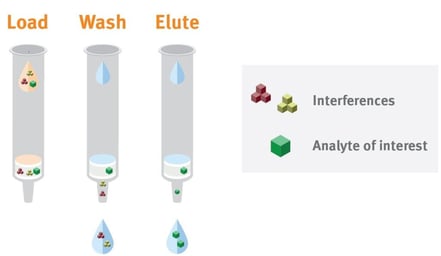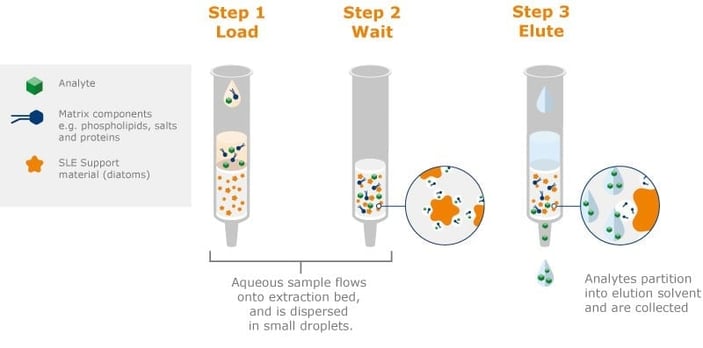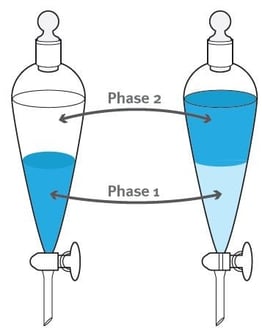Liquid-liquid extraction (LLE), supported liquid extraction (SLE), and solid-phase extraction (SPE) have existed for decades and if you’re doing organic sample preparation, you’re probably quite familiar with at least one of these techniques. But are you familiar with all of them? How are they similar? How are they different? Let’s review!
Solid Phase Extraction (SPE)

Solid-phase extraction is a technique which separates analytes, using physical or chemical adsorption interactions with a solid media. The media is mounted on a sorbent material in the form of either a disk or cartridge. The analytes are retained on the media as the sample passes through the sorbent material. The analytes are then eluted from the media using a solvent in which the analytes are soluble and this solution is retained for analysis. Watch the video below on what is SPE.
Supported Liquid Extraction (SLE)
Supported liquid extraction is a technique that uses an inert support that’s packed into a disk or cartridge, much the way it is with solid-phase extraction.
However, unlike with SPE where the matrix and any potential interferences pass through the sorbent material (unretained), SLE utilizes inert material which retains the entire sample – both the analytes and the matrix components. The analytes are then selectively eluted off the material using an immiscible organic solvent, leaving the matrix components on the media. Unlike SPE, where the sample is loaded onto the column and flows through the sorbent to waste, the entire sample is loaded onto the extraction bed in SLE. Therefore, it’s incredibly important to be sure you’re using a format with sufficient capacity to absorb the whole sample volume. The use of an immiscible solvent to partition and extract analytes makes this technique very similar to liquid-liquid extraction. Watch the video below to see an SLE workflow.
Liquid-Liquid Extraction (LLE)
Liquid-liquid extraction is a technique that uses immiscible solvents to partition analytes based on their relative solubilties. Immiscible solvents are used to extract, or partition, analytes, based on which solvent they are more soluble in. The partitioned analytes are separated when the solvents are physically separated from each other.

This technique is similar to SLE in that water-immiscible solvents are used to partition analytes based on their solubilities. However, unlike SLE, liquid-liquid extraction requires vigorous shaking to get the organic solvent to break up into tiny droplets, which allows the analytes in the aqueous sample a great deal of contact time with a solvent they have a greater affinity for. As the tiny droplets move through (but do NOT dissolve into) the aqueous sample, the analytes migrate from the sample to the organic solvent, where they can then be separated from the aqueous layer.
The downside to shaking the immiscible solvents (in addition to it being a very manual and time-consuming process) is that the formation of these tiny droplets can produce an emulsion which can take a great deal of time and solvent to break. Another downside to this technique is that it’s very hard to automate and usually requires samples to be processed in sequence, rather than in parallel, which reduces the number of sample that can be processed in a day.
Both SPE and SLE are techniques that can be automated and both of them prevent the formation of emulsions. Not only is there no shaking involved with SPE and SLE, but the analytes are retained on a sorbent material before the extraction solvent is introduced. In other words, the aqueous water sample has passed through to waste before the water-immiscible solvent is introduced.
As you can tell, there are some similarities between SPE, SLE and LLE, but there are some key differences as well. These differences can lead to one technique being more appropriate for a particular application over another technique. Stay tuned for additional posts which highlight differences between these techniques, along with specific application examples. For more application and technical tips, click the read more button below.

 Organic Workflow
Organic Workflow Peptide Workflow
Peptide Workflow Scale-Up Flash Purification
Scale-Up Flash Purification  Sample Preparation
Sample Preparation Biomolecule Purification
Biomolecule Purification Oligo synthesis
Oligo synthesis Scavengers and Reagents
Scavengers and Reagents Service & Support
Service & Support Accessories & Spare parts
Accessories & Spare parts Investors
Investors Reports & News
Reports & News The Share
The Share Corporate Governance
Corporate Governance Calendar
Calendar Sustainability
Sustainability Our Offering
Our Offering Our History
Our History Our Locations
Our Locations Leadership
Leadership
